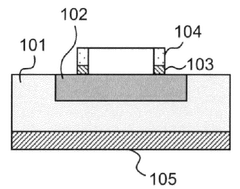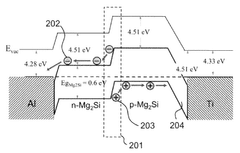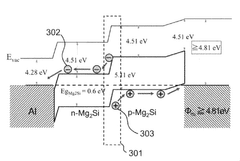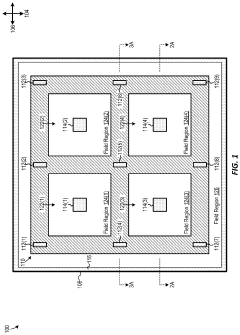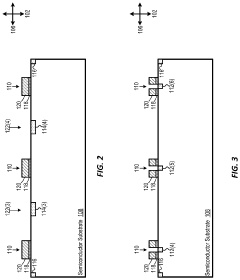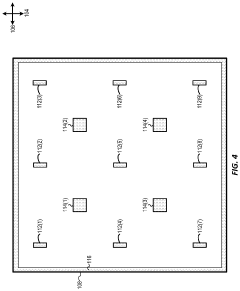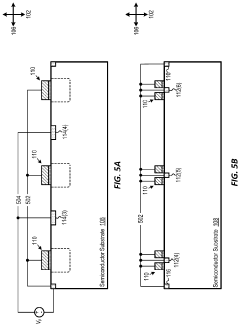Photodiode usage in energy-efficient building automation systems
AUG 21, 20259 MIN READ
Generate Your Research Report Instantly with AI Agent
Patsnap Eureka helps you evaluate technical feasibility & market potential.
Photodiode Technology Evolution and Objectives
Photodiodes have played a pivotal role in the evolution of energy-efficient building automation systems over the past few decades. Initially developed in the 1940s, these semiconductor devices have undergone significant advancements, transforming from simple light sensors to sophisticated components capable of precise light detection and measurement.
The journey of photodiodes in building automation began with basic occupancy sensing applications. Early systems utilized photodiodes to detect the presence of people in a room, enabling rudimentary lighting control. As technology progressed, the integration of photodiodes expanded to include daylight harvesting systems, which adjust artificial lighting based on the amount of natural light available, thus conserving energy.
The miniaturization of photodiodes and improvements in their sensitivity have been crucial factors in their widespread adoption. Modern photodiodes can detect a broader spectrum of light, including infrared and ultraviolet, allowing for more nuanced control of building systems. This enhanced capability has led to the development of smart windows that can automatically adjust tint based on sunlight intensity, further contributing to energy efficiency.
Recent years have seen a surge in the use of photodiodes in advanced building management systems. These devices now form the backbone of integrated sensor networks that continuously monitor and optimize various building parameters. The incorporation of machine learning algorithms has enabled predictive control strategies, where photodiodes provide real-time data to anticipate lighting and HVAC needs based on occupancy patterns and environmental conditions.
The objectives for photodiode technology in energy-efficient building automation systems are multifaceted. Researchers and engineers are striving to develop even more sensitive and reliable photodiodes that can operate effectively in diverse lighting conditions. There is a push towards creating multi-functional sensors that combine photodiode technology with other sensing capabilities, such as temperature and humidity detection, to create comprehensive environmental monitoring solutions.
Another key goal is the development of self-powered photodiodes that can harvest energy from ambient light, eliminating the need for external power sources and reducing maintenance requirements. This advancement would significantly enhance the sustainability of building automation systems and enable the deployment of sensors in hard-to-reach areas.
Looking ahead, the integration of photodiodes with emerging technologies like the Internet of Things (IoT) and artificial intelligence presents exciting possibilities. The objective is to create highly responsive and adaptive building environments that can seamlessly adjust to occupant needs while maximizing energy efficiency. As photodiode technology continues to evolve, its role in shaping the future of smart, sustainable buildings is set to become even more significant.
The journey of photodiodes in building automation began with basic occupancy sensing applications. Early systems utilized photodiodes to detect the presence of people in a room, enabling rudimentary lighting control. As technology progressed, the integration of photodiodes expanded to include daylight harvesting systems, which adjust artificial lighting based on the amount of natural light available, thus conserving energy.
The miniaturization of photodiodes and improvements in their sensitivity have been crucial factors in their widespread adoption. Modern photodiodes can detect a broader spectrum of light, including infrared and ultraviolet, allowing for more nuanced control of building systems. This enhanced capability has led to the development of smart windows that can automatically adjust tint based on sunlight intensity, further contributing to energy efficiency.
Recent years have seen a surge in the use of photodiodes in advanced building management systems. These devices now form the backbone of integrated sensor networks that continuously monitor and optimize various building parameters. The incorporation of machine learning algorithms has enabled predictive control strategies, where photodiodes provide real-time data to anticipate lighting and HVAC needs based on occupancy patterns and environmental conditions.
The objectives for photodiode technology in energy-efficient building automation systems are multifaceted. Researchers and engineers are striving to develop even more sensitive and reliable photodiodes that can operate effectively in diverse lighting conditions. There is a push towards creating multi-functional sensors that combine photodiode technology with other sensing capabilities, such as temperature and humidity detection, to create comprehensive environmental monitoring solutions.
Another key goal is the development of self-powered photodiodes that can harvest energy from ambient light, eliminating the need for external power sources and reducing maintenance requirements. This advancement would significantly enhance the sustainability of building automation systems and enable the deployment of sensors in hard-to-reach areas.
Looking ahead, the integration of photodiodes with emerging technologies like the Internet of Things (IoT) and artificial intelligence presents exciting possibilities. The objective is to create highly responsive and adaptive building environments that can seamlessly adjust to occupant needs while maximizing energy efficiency. As photodiode technology continues to evolve, its role in shaping the future of smart, sustainable buildings is set to become even more significant.
Market Analysis for Smart Building Solutions
The smart building solutions market has experienced significant growth in recent years, driven by increasing demand for energy-efficient and sustainable building management systems. This market segment encompasses a wide range of technologies, including sensors, control systems, and automation platforms that optimize building performance and reduce energy consumption. Photodiodes, as key components in many smart building solutions, play a crucial role in this expanding market.
The global smart building market is projected to reach substantial value in the coming years, with energy management systems being a primary driver of growth. Factors contributing to this expansion include rising energy costs, stringent government regulations on building energy efficiency, and growing awareness of environmental sustainability. The integration of photodiodes in building automation systems aligns perfectly with these market trends, as they enable precise light detection and control, contributing to overall energy savings.
In the context of energy-efficient building automation systems, photodiodes are primarily used in lighting control and daylight harvesting applications. These solutions allow for automatic adjustment of artificial lighting based on the amount of natural light available, significantly reducing energy consumption. The demand for such systems is particularly high in commercial and industrial buildings, where lighting accounts for a substantial portion of energy costs.
The market for photodiode-based smart building solutions is characterized by a mix of established players and innovative startups. Major building automation companies are incorporating advanced sensor technologies, including photodiodes, into their product offerings. Simultaneously, specialized sensor manufacturers are developing cutting-edge photodiode solutions tailored for smart building applications.
Geographically, North America and Europe lead the smart building solutions market, with Asia-Pacific showing the fastest growth rate. This regional distribution is influenced by factors such as technological advancement, regulatory landscape, and the pace of urbanization. The adoption of photodiode-based systems in these regions is driven by different factors, including energy cost savings in North America, sustainability initiatives in Europe, and rapid construction of smart cities in Asia-Pacific.
Looking ahead, the market for photodiode-based smart building solutions is expected to continue its upward trajectory. Emerging trends such as the Internet of Things (IoT) and artificial intelligence are likely to further enhance the capabilities of these systems, leading to more sophisticated and efficient building management solutions. As buildings become increasingly connected and data-driven, the role of photodiodes in energy-efficient automation systems is set to become even more critical, opening up new opportunities for innovation and market growth in the smart building sector.
The global smart building market is projected to reach substantial value in the coming years, with energy management systems being a primary driver of growth. Factors contributing to this expansion include rising energy costs, stringent government regulations on building energy efficiency, and growing awareness of environmental sustainability. The integration of photodiodes in building automation systems aligns perfectly with these market trends, as they enable precise light detection and control, contributing to overall energy savings.
In the context of energy-efficient building automation systems, photodiodes are primarily used in lighting control and daylight harvesting applications. These solutions allow for automatic adjustment of artificial lighting based on the amount of natural light available, significantly reducing energy consumption. The demand for such systems is particularly high in commercial and industrial buildings, where lighting accounts for a substantial portion of energy costs.
The market for photodiode-based smart building solutions is characterized by a mix of established players and innovative startups. Major building automation companies are incorporating advanced sensor technologies, including photodiodes, into their product offerings. Simultaneously, specialized sensor manufacturers are developing cutting-edge photodiode solutions tailored for smart building applications.
Geographically, North America and Europe lead the smart building solutions market, with Asia-Pacific showing the fastest growth rate. This regional distribution is influenced by factors such as technological advancement, regulatory landscape, and the pace of urbanization. The adoption of photodiode-based systems in these regions is driven by different factors, including energy cost savings in North America, sustainability initiatives in Europe, and rapid construction of smart cities in Asia-Pacific.
Looking ahead, the market for photodiode-based smart building solutions is expected to continue its upward trajectory. Emerging trends such as the Internet of Things (IoT) and artificial intelligence are likely to further enhance the capabilities of these systems, leading to more sophisticated and efficient building management solutions. As buildings become increasingly connected and data-driven, the role of photodiodes in energy-efficient automation systems is set to become even more critical, opening up new opportunities for innovation and market growth in the smart building sector.
Photodiode Integration Challenges
The integration of photodiodes into energy-efficient building automation systems presents several significant challenges that need to be addressed for optimal performance and reliability. One of the primary obstacles is the sensitivity of photodiodes to environmental factors such as temperature fluctuations and ambient light interference. These variations can lead to inaccurate readings and compromised system efficiency, necessitating the implementation of robust calibration and compensation mechanisms.
Another critical challenge lies in the miniaturization and cost-effectiveness of photodiode integration. As building automation systems become more sophisticated, there is a growing demand for compact, low-power sensors that can be seamlessly incorporated into various architectural elements. This requires innovative packaging solutions and circuit designs that can maintain high performance while reducing size and power consumption.
The issue of long-term stability and durability is also paramount in photodiode integration. Building automation systems are expected to operate reliably for extended periods, often in harsh environments with exposure to dust, humidity, and varying light conditions. Ensuring that photodiodes maintain their sensitivity and accuracy over time without frequent maintenance or replacement is crucial for the overall system's effectiveness and cost-efficiency.
Integration challenges extend to the realm of data processing and communication. Photodiodes generate analog signals that need to be accurately converted, processed, and transmitted within the building's network infrastructure. This necessitates the development of efficient analog-to-digital conversion techniques and robust communication protocols that can handle the high volume of data generated by multiple sensors throughout the building.
Furthermore, the integration of photodiodes must address the challenge of cross-sensitivity to other environmental factors. For instance, in applications where photodiodes are used for occupancy detection or daylight harvesting, the system must be able to distinguish between changes in natural light and artificial light sources, as well as account for reflections and shadows that may affect sensor readings.
Lastly, the challenge of scalability and interoperability cannot be overlooked. As building automation systems grow in complexity and scale, the photodiode integration solution must be flexible enough to accommodate various building sizes, layouts, and control requirements. This includes ensuring compatibility with existing building management systems and the ability to integrate with other sensor technologies for comprehensive environmental monitoring and control.
Another critical challenge lies in the miniaturization and cost-effectiveness of photodiode integration. As building automation systems become more sophisticated, there is a growing demand for compact, low-power sensors that can be seamlessly incorporated into various architectural elements. This requires innovative packaging solutions and circuit designs that can maintain high performance while reducing size and power consumption.
The issue of long-term stability and durability is also paramount in photodiode integration. Building automation systems are expected to operate reliably for extended periods, often in harsh environments with exposure to dust, humidity, and varying light conditions. Ensuring that photodiodes maintain their sensitivity and accuracy over time without frequent maintenance or replacement is crucial for the overall system's effectiveness and cost-efficiency.
Integration challenges extend to the realm of data processing and communication. Photodiodes generate analog signals that need to be accurately converted, processed, and transmitted within the building's network infrastructure. This necessitates the development of efficient analog-to-digital conversion techniques and robust communication protocols that can handle the high volume of data generated by multiple sensors throughout the building.
Furthermore, the integration of photodiodes must address the challenge of cross-sensitivity to other environmental factors. For instance, in applications where photodiodes are used for occupancy detection or daylight harvesting, the system must be able to distinguish between changes in natural light and artificial light sources, as well as account for reflections and shadows that may affect sensor readings.
Lastly, the challenge of scalability and interoperability cannot be overlooked. As building automation systems grow in complexity and scale, the photodiode integration solution must be flexible enough to accommodate various building sizes, layouts, and control requirements. This includes ensuring compatibility with existing building management systems and the ability to integrate with other sensor technologies for comprehensive environmental monitoring and control.
Current Photodiode Implementation Strategies
01 Improved photodiode structure for enhanced energy efficiency
Advancements in photodiode structure design, including optimized layer compositions and novel materials, can significantly improve energy efficiency. These structural improvements enhance light absorption, reduce recombination losses, and increase overall quantum efficiency.- Improved photodiode structure for enhanced energy efficiency: Advancements in photodiode design focus on optimizing the structure to increase energy efficiency. This includes modifications to the semiconductor layers, electrode configurations, and overall device architecture to improve light absorption and charge collection. These structural improvements lead to higher quantum efficiency and better overall performance of the photodiode.
- Novel materials for high-efficiency photodiodes: Research into new materials for photodiode fabrication aims to enhance energy efficiency. This includes exploring various semiconductor compounds, nanostructures, and hybrid materials that offer superior light absorption and charge transport properties. The use of these advanced materials can significantly improve the photodiode's responsivity and reduce energy losses.
- Integration of energy-efficient photodiodes in systems: Efforts to improve overall system energy efficiency focus on integrating high-performance photodiodes into various applications. This involves optimizing the interface between the photodiode and other components, developing efficient readout circuits, and implementing power management strategies to minimize energy consumption in the entire system.
- Advanced manufacturing techniques for efficient photodiodes: Innovative manufacturing processes are being developed to produce more energy-efficient photodiodes. These techniques aim to improve the precision of device fabrication, reduce defects, and enhance the overall quality of the photodiode. Advanced manufacturing methods can lead to better uniformity, reduced dark current, and improved quantum efficiency.
- Optimization of photodiode operating conditions: Research focuses on optimizing the operating conditions of photodiodes to maximize energy efficiency. This includes studying the effects of temperature, bias voltage, and incident light intensity on photodiode performance. By fine-tuning these parameters, the energy consumption can be minimized while maintaining high sensitivity and responsivity.
02 Integration of energy-efficient circuitry
Incorporating energy-efficient circuitry and readout electronics into photodiode designs can minimize power consumption. This includes low-power amplifiers, efficient signal processing, and optimized bias voltage control, resulting in improved overall energy efficiency of the photodiode system.Expand Specific Solutions03 Advanced manufacturing techniques for energy-efficient photodiodes
Utilizing advanced manufacturing techniques, such as precision doping, nanofabrication, and epitaxial growth methods, can lead to the production of highly energy-efficient photodiodes. These techniques allow for better control over device parameters and reduce defects that can impact energy efficiency.Expand Specific Solutions04 Optimization of light collection and management
Improving light collection and management within photodiodes can enhance energy efficiency. This includes the use of anti-reflective coatings, light trapping structures, and optimized device geometries to maximize light absorption and minimize losses.Expand Specific Solutions05 Temperature management for improved energy efficiency
Implementing effective temperature management strategies in photodiode designs can enhance energy efficiency. This includes the use of heat-dissipating materials, thermal management structures, and temperature-compensated designs to maintain optimal performance across various operating conditions.Expand Specific Solutions
Key Players in Building Automation
The photodiode market for energy-efficient building automation systems is in a growth phase, driven by increasing demand for smart buildings and energy conservation. The market size is expanding, with projections indicating significant growth in the coming years. Technologically, photodiodes for this application are relatively mature, but ongoing innovations are enhancing their performance and efficiency. Key players like STMicroelectronics, Osram, and Infineon Technologies are leading the development of advanced photodiode solutions, while companies such as Siemens and NEC are integrating these components into comprehensive building automation systems, showcasing the technology's practical applications and market readiness.
ams-Osram International GmbH
Technical Solution: ams-Osram has developed advanced photodiode solutions specifically tailored for energy-efficient building automation systems. Their AS7341L spectral sensor integrates multiple photodiodes with on-chip filters, enabling precise light and color sensing for smart lighting control[1]. The device can detect ambient light conditions and adjust artificial lighting accordingly, significantly reducing energy consumption. Additionally, their TSL2540 ambient light sensor employs dual photodiodes with infrared rejection for accurate illuminance measurements in various lighting environments[2]. These sensors are designed for low power operation, typically consuming less than 100µW, making them ideal for battery-operated or energy-harvesting building automation devices[3].
Strengths: High precision light sensing, low power consumption, integrated solutions. Weaknesses: May require additional components for full system integration, potentially higher cost compared to simpler photodiodes.
OSRAM Opto Semiconductors GmbH
Technical Solution: OSRAM Opto Semiconductors has pioneered the development of highly efficient photodiodes for building automation systems. Their SFH 5701 A01 ambient light sensor combines a photodiode with a light-to-frequency converter, offering direct digital output for easy integration into microcontroller-based systems[4]. This sensor features a spectral responsivity close to that of the human eye, ensuring accurate light level detection for occupancy-based lighting control. OSRAM's SFH 7050 sensor integrates three photodiodes for simultaneous detection of red, green, and blue light, as well as infrared, enabling advanced color temperature sensing and circadian rhythm-based lighting adjustments in smart buildings[5]. These sensors typically operate with a supply voltage as low as 1.8V and consume only microamps of current, contributing to overall system energy efficiency[6].
Strengths: Human eye-like spectral response, integrated light-to-frequency conversion, multi-channel color sensing. Weaknesses: May have limited range compared to some competitors, potentially higher cost for multi-channel devices.
Innovative Photodiode Sensing Techniques
Photodiode and light-sensitive device
PatentWO2019187222A1
Innovation
- A photodiode using magnesium silicide (Mg2Si) with electrode materials like nickel, cobalt, and platinum that form silicides or alloys with magnesium, having a work function of 4.81 eV or more, to enhance adhesion and reduce energy barriers for photocarriers, improving sensitivity and durability.
Canal dynamic photodiodes
PatentPendingUS20240222531A1
Innovation
- The canal dynamic photodiode design features a gate structure with apertures surrounding cathode regions, allowing photoelectrons to accumulate quickly under the gate, and engineered doping in field regions to prevent electron flow to cathode regions, thereby reducing triggering time and enhancing sensitivity.
Energy Efficiency Standards and Regulations
Energy efficiency standards and regulations play a crucial role in shaping the adoption and implementation of photodiode-based building automation systems. These standards provide a framework for evaluating and improving the energy performance of buildings, thereby driving the demand for advanced sensing technologies like photodiodes.
The European Union's Energy Performance of Buildings Directive (EPBD) is a key regulatory initiative that mandates the use of smart building technologies to optimize energy consumption. This directive has been instrumental in promoting the integration of photodiodes in lighting control systems, occupancy detection, and daylight harvesting applications. Similarly, the United States Department of Energy's Building Energy Codes Program sets minimum energy efficiency requirements for new and renovated buildings, encouraging the adoption of intelligent building management systems that often incorporate photodiode sensors.
ASHRAE Standard 90.1, widely recognized in North America, provides comprehensive guidelines for energy-efficient building design and operation. This standard specifically addresses lighting control systems and recommends the use of occupancy sensors and daylight-responsive controls, both of which can be effectively implemented using photodiodes. The International Energy Conservation Code (IECC) also emphasizes the importance of automated lighting controls and daylight-responsive systems in reducing energy consumption.
In Asia, countries like Japan and Singapore have implemented stringent energy efficiency regulations. Japan's Building Energy Efficiency Act mandates the use of energy-saving technologies in new constructions, while Singapore's Building Control (Environmental Sustainability) Regulations set high standards for energy performance in buildings. These regulations have spurred the adoption of photodiode-based automation systems in the region.
The global trend towards net-zero energy buildings and carbon neutrality has further accelerated the development and implementation of energy-efficient technologies. Many countries have introduced green building certification systems, such as LEED (Leadership in Energy and Environmental Design) in the United States and BREEAM (Building Research Establishment Environmental Assessment Method) in the UK. These certification programs often award points for the integration of advanced sensing and control systems, including those utilizing photodiodes.
As energy efficiency standards continue to evolve, they are likely to become more stringent and technology-specific. Future regulations may explicitly require the use of photodiode-based systems in certain applications, such as daylight harvesting or occupancy-based lighting control. This regulatory landscape not only drives innovation in photodiode technology but also creates a favorable market environment for energy-efficient building automation systems.
The European Union's Energy Performance of Buildings Directive (EPBD) is a key regulatory initiative that mandates the use of smart building technologies to optimize energy consumption. This directive has been instrumental in promoting the integration of photodiodes in lighting control systems, occupancy detection, and daylight harvesting applications. Similarly, the United States Department of Energy's Building Energy Codes Program sets minimum energy efficiency requirements for new and renovated buildings, encouraging the adoption of intelligent building management systems that often incorporate photodiode sensors.
ASHRAE Standard 90.1, widely recognized in North America, provides comprehensive guidelines for energy-efficient building design and operation. This standard specifically addresses lighting control systems and recommends the use of occupancy sensors and daylight-responsive controls, both of which can be effectively implemented using photodiodes. The International Energy Conservation Code (IECC) also emphasizes the importance of automated lighting controls and daylight-responsive systems in reducing energy consumption.
In Asia, countries like Japan and Singapore have implemented stringent energy efficiency regulations. Japan's Building Energy Efficiency Act mandates the use of energy-saving technologies in new constructions, while Singapore's Building Control (Environmental Sustainability) Regulations set high standards for energy performance in buildings. These regulations have spurred the adoption of photodiode-based automation systems in the region.
The global trend towards net-zero energy buildings and carbon neutrality has further accelerated the development and implementation of energy-efficient technologies. Many countries have introduced green building certification systems, such as LEED (Leadership in Energy and Environmental Design) in the United States and BREEAM (Building Research Establishment Environmental Assessment Method) in the UK. These certification programs often award points for the integration of advanced sensing and control systems, including those utilizing photodiodes.
As energy efficiency standards continue to evolve, they are likely to become more stringent and technology-specific. Future regulations may explicitly require the use of photodiode-based systems in certain applications, such as daylight harvesting or occupancy-based lighting control. This regulatory landscape not only drives innovation in photodiode technology but also creates a favorable market environment for energy-efficient building automation systems.
Cost-Benefit Analysis of Photodiode Systems
The implementation of photodiode systems in energy-efficient building automation presents a complex cost-benefit scenario that requires careful analysis. Initial installation costs for photodiode-based systems can be significant, encompassing hardware expenses for sensors, controllers, and associated wiring, as well as software integration and calibration costs. However, these upfront investments are often offset by long-term energy savings and operational efficiencies.
Energy savings constitute a primary benefit of photodiode systems in building automation. By accurately detecting ambient light levels, these systems enable precise control of artificial lighting, reducing unnecessary energy consumption. Studies have shown that advanced lighting control systems can yield energy savings of 30-50% compared to traditional manual controls. Over time, these reductions in energy usage translate to substantial cost savings on utility bills.
Maintenance costs for photodiode systems are generally low, contributing to their favorable long-term economic profile. Solid-state photodiodes have long operational lifespans, often exceeding 10 years, and require minimal maintenance beyond occasional cleaning and recalibration. This longevity contrasts with traditional occupancy sensors or manual controls, which may require more frequent replacement or adjustment.
Improved occupant comfort and productivity represent intangible but significant benefits of photodiode-based systems. By maintaining optimal lighting conditions throughout the day, these systems can enhance visual comfort, reduce eye strain, and potentially boost workplace productivity. While challenging to quantify precisely, research suggests that improved lighting quality can lead to productivity gains of 2-5% in office environments.
The scalability of photodiode systems offers additional cost benefits for large-scale implementations. As building size increases, the marginal cost of adding sensors decreases, while the potential for energy savings grows. This scalability makes photodiode systems particularly attractive for large commercial or institutional buildings with extensive lighting requirements.
Integration with other building systems, such as HVAC controls, can amplify the cost-effectiveness of photodiode implementations. By synchronizing lighting adjustments with occupancy patterns and thermal management, buildings can achieve more comprehensive energy optimizations, leading to even greater operational cost reductions.
While the benefits of photodiode systems are substantial, it's crucial to consider potential drawbacks in the cost-benefit analysis. Initial system complexity may require specialized training for facility managers, potentially increasing short-term operational costs. Additionally, in buildings with already efficient lighting systems or limited daily occupancy, the return on investment period may be extended.
Energy savings constitute a primary benefit of photodiode systems in building automation. By accurately detecting ambient light levels, these systems enable precise control of artificial lighting, reducing unnecessary energy consumption. Studies have shown that advanced lighting control systems can yield energy savings of 30-50% compared to traditional manual controls. Over time, these reductions in energy usage translate to substantial cost savings on utility bills.
Maintenance costs for photodiode systems are generally low, contributing to their favorable long-term economic profile. Solid-state photodiodes have long operational lifespans, often exceeding 10 years, and require minimal maintenance beyond occasional cleaning and recalibration. This longevity contrasts with traditional occupancy sensors or manual controls, which may require more frequent replacement or adjustment.
Improved occupant comfort and productivity represent intangible but significant benefits of photodiode-based systems. By maintaining optimal lighting conditions throughout the day, these systems can enhance visual comfort, reduce eye strain, and potentially boost workplace productivity. While challenging to quantify precisely, research suggests that improved lighting quality can lead to productivity gains of 2-5% in office environments.
The scalability of photodiode systems offers additional cost benefits for large-scale implementations. As building size increases, the marginal cost of adding sensors decreases, while the potential for energy savings grows. This scalability makes photodiode systems particularly attractive for large commercial or institutional buildings with extensive lighting requirements.
Integration with other building systems, such as HVAC controls, can amplify the cost-effectiveness of photodiode implementations. By synchronizing lighting adjustments with occupancy patterns and thermal management, buildings can achieve more comprehensive energy optimizations, leading to even greater operational cost reductions.
While the benefits of photodiode systems are substantial, it's crucial to consider potential drawbacks in the cost-benefit analysis. Initial system complexity may require specialized training for facility managers, potentially increasing short-term operational costs. Additionally, in buildings with already efficient lighting systems or limited daily occupancy, the return on investment period may be extended.
Unlock deeper insights with Patsnap Eureka Quick Research — get a full tech report to explore trends and direct your research. Try now!
Generate Your Research Report Instantly with AI Agent
Supercharge your innovation with Patsnap Eureka AI Agent Platform!

